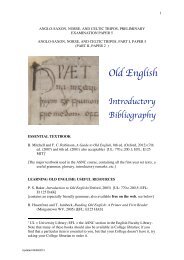Scandinavian history in the Viking age - Department of Anglo-Saxon ...
Scandinavian history in the Viking age - Department of Anglo-Saxon ...
Scandinavian history in the Viking age - Department of Anglo-Saxon ...
Create successful ePaper yourself
Turn your PDF publications into a flip-book with our unique Google optimized e-Paper software.
<strong>Scand<strong>in</strong>avian</strong> History <strong>in</strong> <strong>the</strong> Vik<strong>in</strong>g Age<br />
Aside from tales <strong>of</strong> Vik<strong>in</strong>g expeditions <strong>in</strong> England, it is significant for <strong>the</strong> (<strong>of</strong>ten all too brief) accounts <strong>of</strong><br />
<strong>Scand<strong>in</strong>avian</strong> political <strong>history</strong>, especially relations with, and between, <strong>the</strong> Danes and Norwegians <strong>in</strong> <strong>the</strong><br />
late tenth and eleventh centuries. Text: The <strong>Anglo</strong>-<strong>Saxon</strong> chronicle: a collaborative edition, gen. edd. D.<br />
Dumville et al. (1983 ff.) [UL 541:14.c.95.40 ff.] (all <strong>the</strong> major manuscripts now edited); for more<br />
general use: B. Thorpe, The <strong>Anglo</strong>-<strong>Saxon</strong> chronicle, accord<strong>in</strong>g to <strong>the</strong> several orig<strong>in</strong>al authorities, 2 vols,<br />
RS 23 (1861; repr. 1964) [UL R542.30.23] (second volume conta<strong>in</strong>s English translation); C. Plummer,<br />
Two <strong>of</strong> <strong>the</strong> <strong>Saxon</strong> chronicles parallel, 2 vols (1892-99; rev. repr. 1952) [UL 717:3.d.95.1-2]. Transl.:<br />
(B81):145-261, and (B82):103-215; M.J. Swanton, The <strong>Anglo</strong>-<strong>Saxon</strong> chronicle (1996) [UL<br />
541:14.c.95.104]<br />
[B87] Æ<strong>the</strong>lweard was an <strong>Anglo</strong>-<strong>Saxon</strong> nobleman who compiled a <strong>history</strong> <strong>of</strong> <strong>the</strong> English, largely based<br />
on earlier chronicles, around <strong>the</strong> end <strong>of</strong> <strong>the</strong> tenth century; although add<strong>in</strong>g relatively little to <strong>the</strong> accounts<br />
<strong>of</strong> <strong>the</strong> Vik<strong>in</strong>gs <strong>in</strong> England, his adaptation <strong>of</strong> <strong>Scand<strong>in</strong>avian</strong> names <strong>in</strong> particular seems to imply some<br />
contacts with, and <strong>in</strong>terest <strong>in</strong>, <strong>the</strong> Danes. Text and transl.: A. Campbell, The chronicle <strong>of</strong> Æ<strong>the</strong>lweard<br />
(1962) [UL 716:01.c.2.21]<br />
Royal biographies<br />
The various royal biographies composed <strong>in</strong> <strong>Anglo</strong>-<strong>Saxon</strong> England, occasionally verg<strong>in</strong>g on <strong>the</strong><br />
hagiographical for some k<strong>in</strong>gs, are <strong>of</strong> diffuse value; <strong>the</strong> earlier ones are naturally most useful <strong>in</strong> a<br />
<strong>Scand<strong>in</strong>avian</strong> context for <strong>the</strong>ir observations on <strong>the</strong> Vik<strong>in</strong>g <strong>in</strong>vaders, while <strong>the</strong> later ones provide essential<br />
portraits <strong>of</strong> <strong>the</strong> activities <strong>of</strong> <strong>the</strong> <strong>Anglo</strong>-Danish k<strong>in</strong>gs <strong>in</strong> <strong>the</strong> early eleventh century.<br />
[B90] Asser’s biography <strong>of</strong> k<strong>in</strong>g <strong>of</strong> Alfred <strong>of</strong> Wessex from <strong>the</strong> end <strong>of</strong> <strong>the</strong> n<strong>in</strong>th century is <strong>of</strong> great<br />
<strong>in</strong>terest for Vik<strong>in</strong>g activity <strong>in</strong> England. Text: W.H. Stevenson, Asser’s life <strong>of</strong> k<strong>in</strong>g Alfred (1904), repr.<br />
with <strong>in</strong>tro. by D. Whitelock (1959) [UL 9540.d.443]. Transl.: S. Keynes and M. Lapidge, Alfred <strong>the</strong><br />
great: Asser’s Life <strong>of</strong> K<strong>in</strong>g Alfred and o<strong>the</strong>r contemporary sources (1983) [UL 9540.d.1016]; excerpts<br />
also transl. (B81):289-303<br />
[B91] Abbo <strong>of</strong> Fleury composed his Passio sancti Eadmundi ‘life <strong>of</strong> sa<strong>in</strong>t Edmund’ on <strong>the</strong> k<strong>in</strong>g <strong>of</strong> East<br />
Anglia who was killed <strong>in</strong> 869 by rampag<strong>in</strong>g Danes; it is additionally significant as <strong>the</strong> major fixed<br />
chronological po<strong>in</strong>t employed by <strong>the</strong> earliest Icelandic historians such as Ari (B255) for dat<strong>in</strong>g <strong>the</strong><br />
settlement <strong>of</strong> Iceland. Text: M. W<strong>in</strong>terbottom, Three lives <strong>of</strong> English sa<strong>in</strong>ts (1972), 65-87 [UL<br />
118:3.c.95.17]. Text and transl.: Lord F. Hervey, Corolla sancti Eadmundi: <strong>the</strong> garland <strong>of</strong> sa<strong>in</strong>t Edmund<br />
k<strong>in</strong>g and martyr (1907), 6-59 [UL RC.20.16] (with much o<strong>the</strong>r material, <strong>in</strong>clud<strong>in</strong>g later versions <strong>of</strong> Abbo<br />
transl. <strong>in</strong>to Old English). Commentary: A. Gransden, ‘Abbo <strong>of</strong> Fleury’s Passio sancti Eadmundi’, Revue<br />
Bénédict<strong>in</strong>e 105 (1995), 20-78<br />
[B92] The Encomium Emmae was composed by a cleric <strong>in</strong> St Omer dur<strong>in</strong>g <strong>the</strong> reign <strong>of</strong> Harthacnut<br />
(1040-42) for queen Emma; it is <strong>of</strong> great value as a source for <strong>the</strong> <strong>Anglo</strong>-Danish k<strong>in</strong>gs, especially <strong>the</strong><br />
position <strong>of</strong> <strong>the</strong> shadowy k<strong>in</strong>g <strong>of</strong> Denmark Harald Sve<strong>in</strong>sson, bro<strong>the</strong>r <strong>of</strong> Knut, but is a highly tendentious<br />
source <strong>in</strong> many ways. Text: (B635): II,375-426. Text and transl.: A. Campbell, Encomium Emmae<br />
reg<strong>in</strong>ae, Camden third series 72 (1949) [UL 540:01.c.1.239]; repr. with <strong>in</strong>troduction by S. Keynes,<br />
Camden classic repr<strong>in</strong>ts 4 (1998) [UL 540:01.c.4.4]. For fur<strong>the</strong>r commentary on <strong>the</strong> purposes <strong>of</strong> <strong>the</strong><br />
author, see F. Lifshitz, ‘The Encomium Emmæ reg<strong>in</strong>æ: a “political pamphlet” <strong>of</strong> <strong>the</strong> eleventh century?’,<br />
Hask<strong>in</strong>s Society journal 1 (1989), 39-50; A. Orchard, ‘The literary background to <strong>the</strong> Encomium Emmae<br />
reg<strong>in</strong>ae’, Journal <strong>of</strong> Medieval Lat<strong>in</strong> 11 (2001), 156-83.<br />
Hagiography<br />
It is at once both surpris<strong>in</strong>g and irritat<strong>in</strong>g that <strong>the</strong>re are almost no English sources which talk <strong>of</strong><br />
missionaries at work <strong>in</strong> Scand<strong>in</strong>avia <strong>in</strong> <strong>the</strong> late Vik<strong>in</strong>g <strong>age</strong>, even though on o<strong>the</strong>r grounds we suspect<br />
<strong>the</strong>re must have been many and that <strong>the</strong>ir <strong>in</strong>fluence on <strong>the</strong> <strong>Scand<strong>in</strong>avian</strong> church was extensive (L132 ff.).<br />
[B95] Willibrord, <strong>the</strong> renowned Apostle <strong>of</strong> <strong>the</strong> Frisians, also made a brief visit to Denmark <strong>in</strong> <strong>the</strong> early<br />
eighth century accord<strong>in</strong>g to his life by Alcu<strong>in</strong>. Text: W. Levison, ‘Vita Willibrordi archiepiscopi<br />
Traiectensis’, Passiones vitaeque sanctorum aevi Merov<strong>in</strong>gici, MGH SRM 7 (1920), 81-141 [UL<br />
R560.G113]. Text and German transl.: H.-J. Reischmann, Willibrord, Apostel der Friesen: se<strong>in</strong>e Vita<br />
nach Alku<strong>in</strong> und Thi<strong>of</strong>rid, late<strong>in</strong>isch-deutsch (1989) [UL 62:1.c.95.30]. Transl.: C.H. Talbot, The <strong>Anglo</strong>-<br />
<strong>Saxon</strong> missionaries <strong>in</strong> Germany, be<strong>in</strong>g <strong>the</strong> lives <strong>of</strong> St. Willibrord, Boniface, Sturm, Leoba and Lebu<strong>in</strong>,<br />
13






